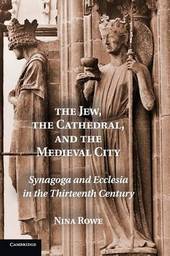
|
The Jew, the Cathedral and the Medieval City: Synagoga and Ecclesia in the Thirteenth Century
Hardback
Main Details
| Title |
The Jew, the Cathedral and the Medieval City: Synagoga and Ecclesia in the Thirteenth Century
|
| Authors and Contributors |
By (author) Nina Rowe
|
| Physical Properties |
| Format:Hardback | | Pages:346 | | Dimensions(mm): Height 254,Width 180 |
|
| Category/Genre | Religious subjects depicted in art |
|---|
| ISBN/Barcode |
9780521197441
|
| Classifications | Dewey:734.25 |
|---|
| Audience | | Postgraduate, Research & Scholarly | |
|---|
| Illustrations |
162 Halftones, unspecified
|
|
Publishing Details |
| Publisher |
Cambridge University Press
|
| Imprint |
Cambridge University Press
|
| Publication Date |
4 April 2011 |
| Publication Country |
United Kingdom
|
Description
In the thirteenth century, sculptures of Synagoga and Ecclesia - paired female personifications of the Synagogue defeated and the Church triumphant - became a favoured motif on cathedral facades in France and Germany. Throughout the preceding centuries, the Jews of northern Europe prospered financially and intellectually, a trend that ran counter to the long-standing Christian conception of Jews as relics of the prehistory of the Church. In this book, Nina Rowe examines the sculptures as defining elements in the urban Jewish-Christian encounter. She locates the roots of the Synagoga-Ecclesia motif in antiquity and explores the theme's public manifestations at the cathedrals of Reims, Bamberg, and Strasbourg, considering each example in relation to local politics and culture. Ultimately, she demonstrates that royal and ecclesiastical policies to restrain the religious, social, and economic lives of Jews in the early thirteenth century found a material analog in lovely renderings of a downtrodden Synagoga, placed in the public arena of the city square.
Author Biography
Nina Rowe is an Assistant Professor of Art History at Fordham University. The recipient of numerous fellowships and grants, she co-authored (with Sandra Hindman, Michael Camille and Rowan Watson) Manuscript Illumination in the Modern Age: Recovery and Reconstruction and co-edited (with David Areford) Excavating the Medieval Image: Manuscripts, Artists, Audiences - Essays in Honor of Sandra Hindman. She has published articles in the journals Gesta and Studies in Iconography, as well as in various edited volumes.
Reviews'Rowe's approach to her work is impressively versatile, drawing historical, textual, and material evidence into synthesis with formal and stylistic observations to walk the line attentively between the worm's-eye and the bird's-eye view of her subject. The breadth and soundness of the resulting book will interest a wide range of scholars in fields from art history and Jewish studies to theology, anthropology and beyond. The Jew, the Cathedral and the Medieval City ... represents a masterful scholarly accomplishment and a signal contribution to medieval studies.' The Medieval Review 'Rowe's study represents a valuable contribution to the corpus of scholarship on Jewish-Christian interaction, medieval urban history and Gothic art. Scholars and students alike will want to familiarize themselves with Rowe's arguments and imitate her interpretative methodologies.' German History 'The Jew, the Cathedral and the Medieval City is an excellent example of a study on the border between history and art history. ... Rowe's work ... sheds new light on the Synagoga-Ecclesia theme through a probing study of the political and ecclesiastical milieux that generated the monumental ensembles at three important cathedrals: Reims, Bamberg and Strasbourg.' Bulletin monumental 'Rowe's book is one of very few studies of German Gothic sculpture in English; that alone makes it a significant contribution. ... What makes Rowe's study novel is her integration of the images into the social and political circumstances of their production and consumption, above all, those that involved the resident clergy's interactions with and attitudes toward Jews. The Art Bulletin 'Nina Rowe has succeeded in providing scholars with a provocative foray into the difficult problem of the relationship of artistic evidence to the lived realities of social and political life. Often she is forced to speculate, but she is always forthright about the limitations of her evidence. Not everyone will agree with all her conclusions, but no one working in the general area of her concerns can afford to ignore them. Speculum
|